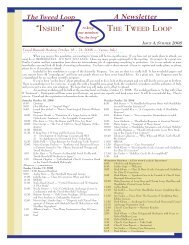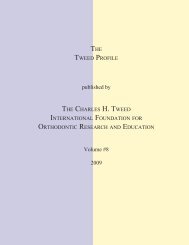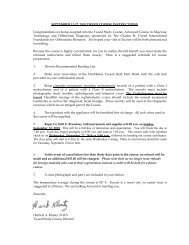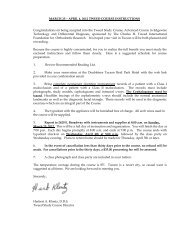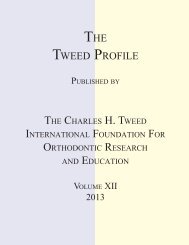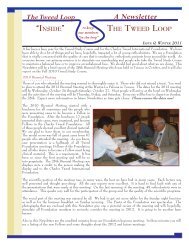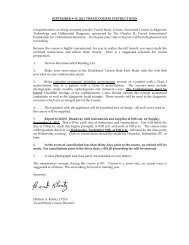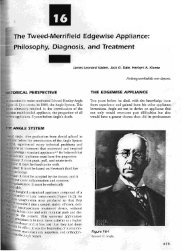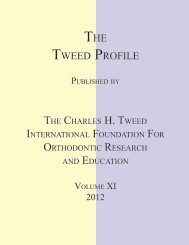© 2006 - The Charles H. Tweed International Foundation
© 2006 - The Charles H. Tweed International Foundation
© 2006 - The Charles H. Tweed International Foundation
Create successful ePaper yourself
Turn your PDF publications into a flip-book with our unique Google optimized e-Paper software.
A Comparative Study of Facial Profiles in Extraction and NonextractionTreatmentRichard Don James, DDS, MSDOklahoma City, Okla.<strong>The</strong> debate concerning the extraction of teeth and its effect on the facial profile began more than 100 years ago.It is still an ongoing topic of discussion. All orthodontists have heard colleagues say, “I don’t extract teeth because itcreates a dished-in face,” or, “I don’t extract teeth because I like a nice full pleasing smile.” Statements like these, madewithout any scientific evidence, led to this study.REVIEW OF THE LITERATUREFacial beauty and harmony were paramount treatment goals of Dr. Edward Angle. He believed that the faceof the Greek god Apollo contained all the essentials of harmony and beauty. From his studies, he developed the profile“line of harmony.” By the time his seventh edition was published, he believed that maintenance of a full complement ofteeth would establish the best harmony and that Nature would allow this to happen through growth, development, andfunction. 1,2<strong>Tweed</strong>, 3 Angle’s disciple, became disappointed with the facial balance found in a great majority of the patientswhom he had treated without tooth removal, but he liked the facial esthetics of patients for whom he was able to uprightthe mandibular incisors so the FMIA value could approach 60° to 68° . His clinical studies led him to retreat more than100 of his “nonextraction” patients with premolar extraction.After many years of studying and comparing untreated normal patients who had pleasing facial balance withpatients he had treated both with and without extraction, he developed the “Diagnostic Facial Triangle” to equate toothposition with facial esthetics.Downs 4 believed that restoring or maintaining balance and harmony of the component parts of the face in manycases required extraction of teeth. His “facial angle” and “angle of convexity” are hard tissue measurements that reflectfacial type and form, but they do not take into account the soft tissue, especially soft tissue chin.Holdaway 5 studied facial balance and developed an 11-mesaurement soft tissue analysis that included “superiorsulcus depth” and the “H line.” He was not fond of the “nasolabial angle” because he believed that it did not adequatelydescribe contour in the subnasal profile.To quantify facial contour, Ricketts 6,7 used a millimeter measurement made from the vermillion border of thelower lip to the “facial esthetic line.” For young patients, he found the measurement to have a mean of 0 mm with arange of ±3 mm. A mean of -4 mm was found in the slightly older patient.Merrifield’s 8 study of facial profiles in a sample of 120 untreated normal patients and treated patients withpleasing facial esthetics led to the development of the “Z-angle” to quantify balance, or lack thereof, of the lower facialprofile. <strong>The</strong> Z-angle is the inner inferior angle formed by the intersection of the Frankfort horizontal plane and the“profile line” (a line that is tangent to the soft tissue chin and the most prominent lip). He found the normal Z-anglerange in his sample to be 72° to 83°.MATERIAL AND METHODS<strong>The</strong> purpose of the study was to quantitatively and visually compare the facial profiles and soft tissue balancefound in patients who underwent premolar extraction with the profiles and facial balance of patients who did notundergo premolar extraction. A sample of 170 consecutively treated patients was collected over a 20-month period.One hundred-eight of these patients were treated after extraction of premolars, and 62 were treated without premolarextraction. <strong>The</strong> patient records used in the study consisted of pretreatment and posttreatment facial photographs,cephalographs, and tracings. <strong>The</strong> photographs were ¼ life size in all three views: profile, fontal, and smile.<strong>The</strong> quantitative measurements selected were (1) an angular measurement – the Z-angle of Merrifield and (2)a linear measurement – the lower lip to the esthetic line of Ricketts, called in thisstudy, the “E-value.”<strong>The</strong> Z-angle and E-value were chosen for their ease and accuracy tomeasure and their relevance to lip position and lip change, thus makingcomparisons relevant and easy to evaluate. As described earlier, the Z-angle is theangular measurement made by the profile line and the Frankfort horizontal plane(Fig. 1). <strong>The</strong> Z-angle in this example is 76°.<strong>The</strong> E-value is the distance in millimeters from the most anterior point of thevermillion border of the lower lip to the esthetic line. If the lower lip is in front ofthe esthetic line, the E-value is positive. If the lower lip is behind the esthetic line,the E-value is negative. <strong>The</strong> E-value in this example is -4mm. (Fig. 2).Fig. 1. Z-angle measurement.20



